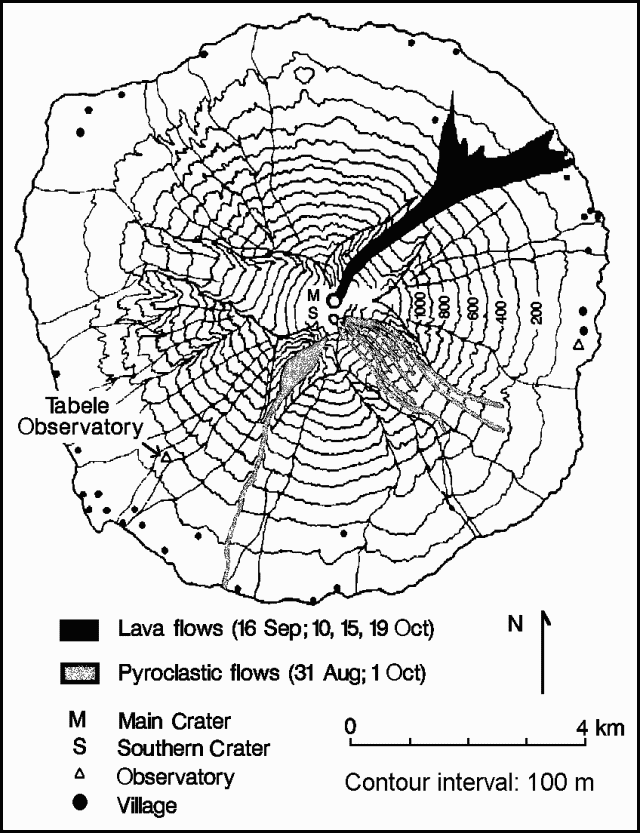Report on Manam (Papua New Guinea) — September 1992
Bulletin of the Global Volcanism Network, vol. 17, no. 9 (September 1992)
Managing Editor: Lindsay McClelland.
Manam (Papua New Guinea) Strong explosions; pyroclastic and lava flows
Please cite this report as:
Global Volcanism Program, 1992. Report on Manam (Papua New Guinea) (McClelland, L., ed.). Bulletin of the Global Volcanism Network, 17:9. Smithsonian Institution. https://doi.org/10.5479/si.GVP.BGVN199209-251020
Manam
Papua New Guinea
4.08°S, 145.037°E; summit elev. 1807 m
All times are local (unless otherwise noted)
"Manam continued erupting in September, with a paroxysmal phase of activity from Main Crater at mid-month. Following the paroxysmal eruption from Southern Crater on 31 August (BGVN 17:08), its activity subsided to a low level in early September. Emissions consisted of white and blue vapours at low to moderate rates.
"Southern Crater emissions changed on 13 September to forceful emissions of thick dark-grey ash clouds and incandescent lava fragments. This activity continued on 14 September, then subsided, and there was a return to emission of white and blue vapours. The stronger visible activity was accompanied by a rise in seismicity.
"Main Crater, which had been inactive since mid-June, began to show signs of re-awakening on 11 September when forceful emissions of thick white vapour clouds were observed. On 15 September, bright glow was observed over Main Crater, and at 0500 on 16 September, above the atmospheric cloud-cover, a high eruption column was seen, indicating that a paroxsymal eruption was in progress. The ash column rose several kilometers above the crater before being blown to the NW. Reports from inhabitants on the N side of the island indicate generation of small pyroclastic flows followed later by lava extrusion into the NE valley. The new lava covered a substantial portion of the April-June lava flows and reached to within 2 km of the coast (figure 4). At night on 16 September, weak-to-bright glow was observed, punctuated by intermittent projection of incandescent lava fragments to 50 m above the crater. Lava effusion ceased by 17 September.
 |
Figure 4. Topographic sketch map of Manam Island, showing pyroclastic and lava flows through October 1992, villages, and observatory sites. Courtesy of RVO. |
"A somewhat weaker phase of activity from Main Crater took place on 20 September, starting at about 1845 and ending at about 2130. Seismic activity showed a corresponding increase during this period. Dense, dark, ash clouds were released and rose several kilometers above the crater. Incandescent lava fragments within the eruption column reached 500-700 m above the crater, but most fell into the crater. For the remainder of the month, Main Crater activity was moderate, with emissions of thick white vapour and occasional grey ash clouds. Weak glow above the crater continued to be observed until the end of the month. Light ashfalls took place intermittently on the W flank throughout the month.
"Seismicity continued to consist of low-frequency events and sub-continuous tremor. Over the course of the month seismicity showed a number of fluctuations but the general trend was one of increased amplitude. Measurements from water-tube tiltmeters . . . showed a 4 µrad deflation to mid-September following the paroxysmal eruption of 31 August. By the end of September the volcano had re-inflated by 1 µrad.
"Further eruptive activity took place in October. During a paroxysmal eruption from Southern Crater on 1 October, pyroclastic flows descended the SW and SE valleys and moderate-to-heavy scoria-fall took place on the W side of the island. The pyroclastic flows were contained within the valleys and did not cause any damage. The scoria-fall reportedly damaged some food gardens. On 10 October, voluminous lava effusion from Main Crater resulted in lava flowing into the sea at two points in the NE Valley. Another phase of strong lava effusion occurred on 15 October. Part of the lava flow overwhelmed three houses in a village near the edge of the NE valley and entered the sea.
"Yet another effusive phase from Main Crater was reported on 19 October. The volume of lava erupted may have been smaller than the amounts erupted on 10 and 15 October. The emplacement of pyroclastic flows and lava flows in the main valleys at Manam has clearly demonstrated the high hazard potential of these parts of the volcano. Recommendations have been made for the evacuation of settlements near the SW and NE valleys. It is not anticipated that the entire population (6,000 residents) of Manam will need to be evacuated."
Geological Summary. The 10-km-wide island of Manam, lying 13 km off the northern coast of mainland Papua New Guinea, is one of the country's most active volcanoes. Four large radial valleys extend from the unvegetated summit of the conical basaltic-andesitic stratovolcano to its lower flanks. These valleys channel lava flows and pyroclastic avalanches that have sometimes reached the coast. Five small satellitic centers are located near the island's shoreline on the northern, southern, and western sides. Two summit craters are present; both are active, although most observed eruptions have originated from the southern crater, concentrating eruptive products during much of the past century into the SE valley. Frequent eruptions, typically of mild-to-moderate scale, have been recorded since 1616. Occasional larger eruptions have produced pyroclastic flows and lava flows that reached flat-lying coastal areas and entered the sea, sometimes impacting populated areas.
Information Contacts: B. Talai and C. McKee, RVO.

